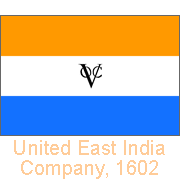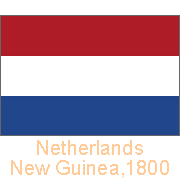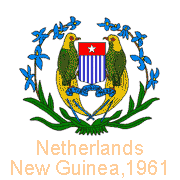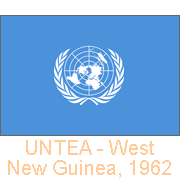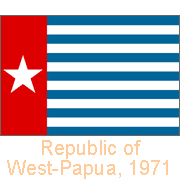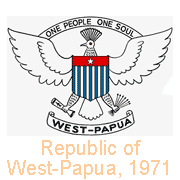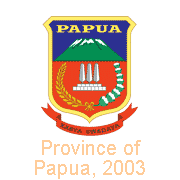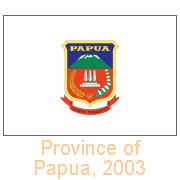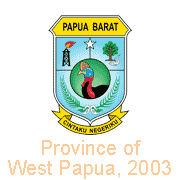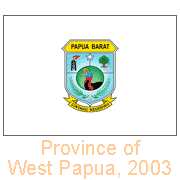Flags from West-Papua
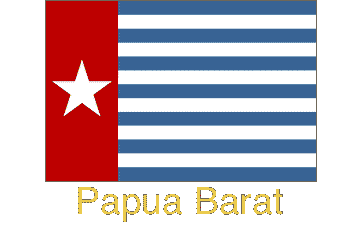
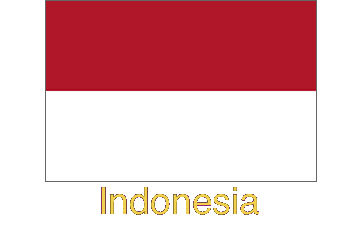
A Flag history of West-Papua
Towards the end of the sixteenth century the west coast of the island of New Guinea came under influence of the Sultan of Ternate, an island in the northern Moluccas. The Sultan of Tidore, the island just east of Ternate, claimed sovereignty over the coast of New Guinea and as a consequence the "Vereenigde Oostindische Compagnie" (V.O.C. - United East India Company), a Dutch trading Company founded in 1602, considering the Moluccas as part of their trading empire, recognised the Sultan's claim and so New Guinea became nominally Dutch.
you may then send it as a postcard if you wish.
The V.O.C.'s house flag was the Dutch Tricolour with the Company emblem placed on the white stripe. The upper stripe of the flag was changed to red between 1630 and 1660, possibly because darker colours were better visible at sea against a light sky. When the United East India Company went bankrupt and was formally dissolved in 1800, its possessions and debt were taken over by the government of the Dutch Batavian Republic and the VOC's territories became the Dutch East Indies. Over the course of the 19th and early 20th century it expanded to include the whole of the Indonesian archipelago, including west New Guinea. The red-white-blue flag of the Netherlands, officially established on 14 February 1796, became the flag of Netherlands New Guinea.
In 1945 Soekarno had declared independence of Indonesia, but the Dutch re-established control and when Indonesian independence was finally granted in 1949, New Guinea remained Dutch. Although most Indonesians considered the territory part of Indonesia on the grounds it had been part of the Dutch East Indies, the Dutch disagreed as its inhabitants were Melanesians and culturally completely different from Indonesians. A program to prepare it for self rule was instituted and on 1 December 1961 the "Morning Star flag" was first raised as a National flag, next to the Dutch flag. The flag was designed by Nicolaas Jouwe and had been adopted on 20 November 1961; the 13 stripes represent the tribes, the red stripe the political struggle, the morning star is the star of hope, and the red-white-blue stands for gratitude. A Coat of Arms was also adopted.
Following clashes between the Dutch and Indonesian military in 1961, the Netherlands agreed to mediation by the United Nations, resulting in the New York Agreement of September 1962 in which authority was transferred to UNTEA (United Nations Temporary Executive Authority). The flag used was the light blue flag of the United Nations, dating from 20 October 1947, featuring a world map representing all the people of the world, surrounded by olive branches, a symbol for peace. On 1 May 1963 authority was transferred from UNTEA to Indonesia, with the proviso that the Indonesians would allow the Papuans to decide if they wanted to become independent or be a part of Indonesia. From that time the only flag allowed was the "Merah-Puti" (red and white) national flag of Indonesia. Based on the banner of the 13th century Majapahit Empire, it was first hoisted on 17 August 1945 when Indonesia declared its independence from the Netherlands.
The "Morning Star flag" disappeared when the territory came under U.N. administration and was forbidden by the Indonesians. The Organisasi Papua Merdeka (OPM, Organisation for a Free Papua) was founded in December 1963 and adopted the flag as its own. On 1 July 1971 a "Republic of West Papua" was declared and adopted a Coat of Arms, but went unrecognised; raising the flag is considered an act of treason and many Papuans have been killed by the Indonesian military or given long prison sentences. However, Indonesia did make some concessions on autonomy when president Abdurrahman Wahid agreed to rename the province "Papua" as a gesture to the West Papuans on 26 December 2001 and under Papua's Special Autonomy Law, ratified in 2002, it was stated the West Papuan flag may be raised in Papua so long as the flag of Indonesia is also raised and is higher than the Morning Star flag. In practice the Papuans consider it a flag of independence and will not raise the Indonesian flag with it; as a consequence people are still arrested, imprisoned or shot when they raise the flag and it remains a powerful symbol of freedom for Papuans abroad. In 2003 the province of Papua was split into two, with a separate province of "West-Papua" created in the Bird's Head Peninsula and surrounding islands to its west; separate coats of arms were created for these Indonesian provinces, with Indonesian mottos and white flags featuring those arms as provincial flags, while the Morning Star flag remains forbidden.

